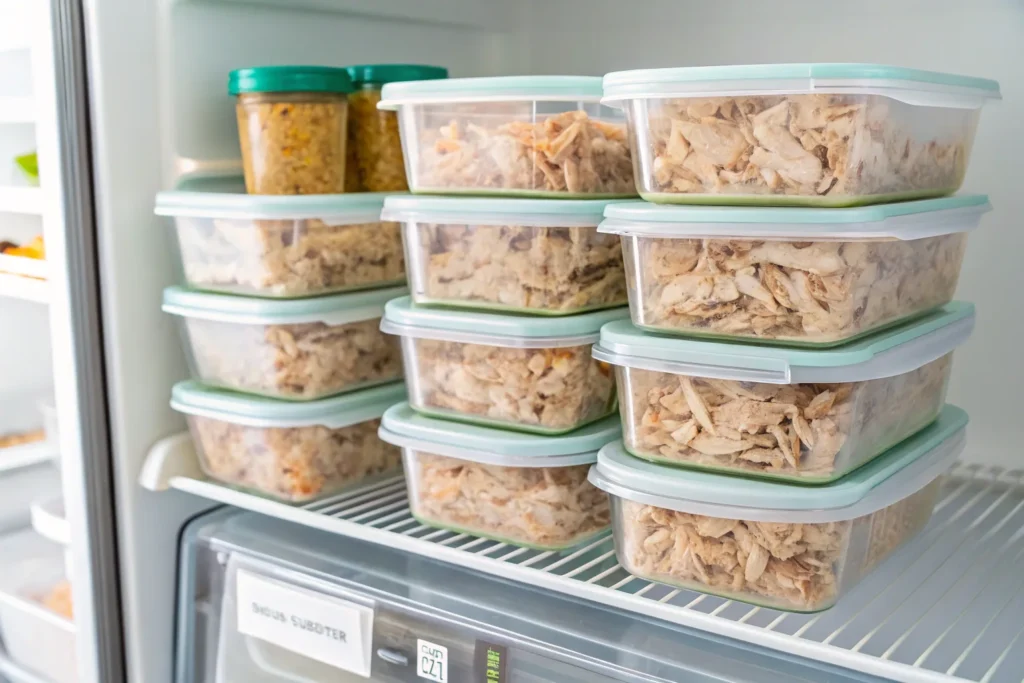How to know if rotisserie chicken has gone bad? If you frequently rely on rotisserie chicken for quick, easy meals, this is an important question to answer. Rotisserie chicken is a lifesaver for busy days, but eating spoiled chicken can lead to foodborne illnesses. Recognizing the signs of spoilage is critical for your health and safety.
In this guide, you’ll learn to spot the signs of spoilage, store rotisserie chicken properly, and even extend its shelf life. Whether you’re curious about how to know if rotisserie chicken has gone bad or looking for creative ways to use leftovers, you’ll find practical answers here, check out Leftover Rotisserie Chicken Recipe or learn How to Jazz Up a Rotisserie Chicken.
Why It’s Important to Check Your Rotisserie Chicken
Rotisserie chicken is a versatile ingredient, but ensuring it’s fresh is essential for both safety and taste. Understanding how to know if rotisserie chicken has gone bad helps you avoid foodborne illnesses, reduce waste, and enjoy meals with confidence. Here’s why checking for spoilage matters:
1. Prevent Foodborne Illnesses
Spoiled chicken can harbor harmful bacteria like salmonella or listeria, which can cause food poisoning. Symptoms include nausea, diarrhea, and abdominal pain. Therefore, identifying bad chicken can help you avoid serious health risks.
2. Save Money and Reduce Waste
Throwing away chicken because you missed the signs of spoilage is not only disappointing but also wasteful. By spotting issues early and storing chicken properly, you can extend its usability and avoid unnecessary waste.
3. Enhance Meal Confidence
When you know your chicken is fresh and safe to eat, you can confidently use it in your favorite recipes. Whether it’s a creamy casserole or a light salad, fresh chicken elevates the quality of your meals.
Pro Tip:
If you’re ever in doubt about the freshness of your rotisserie chicken, it’s better to err on the side of caution. Spoiled chicken is never worth the risk.
Signs That Rotisserie Chicken Has Gone Bad
Knowing how to know if rotisserie chicken has gone bad involves looking for key signs like foul smells, slimy textures, and discoloration. These indicators ensure you’re not consuming spoiled chicken, which can be harmful to your health. Here’s how to tell if your chicken has gone bad:

1. Unpleasant Smell
Fresh rotisserie chicken has a mild aroma that’s usually appetizing. If the chicken smells sour, rancid, or “off,” it’s a strong indicator of spoilage. Trust your nose—it’s often the first sign something isn’t right.
2. Slimy or Sticky Texture
A slimy or sticky coating on the chicken surface is a telltale sign of bacterial growth. Fresh chicken should feel firm and slightly moist, not slimy or slippery.
3. Discoloration
Pay attention to the color of the chicken. Fresh meat is pale or slightly golden, depending on the preparation. If you notice green, gray, or iridescent hues, it’s time to toss it out.
4. Visible Mold
Mold is a definite sign that the chicken has gone bad. Even if you spot just a small amount of mold, the entire chicken should be discarded to avoid contamination.
5. Unpleasant Taste
If the chicken tastes sour, bitter, or otherwise unusual, it’s likely spoiled. However, this should be your last line of detection—ideally, you’d identify spoilage before taking a bite.
Pro Tip:
Always inspect the chicken thoroughly before using it. If any of these signs are present, it’s best to discard the chicken to avoid potential health risks.
How to Properly Store Rotisserie Chicken
Proper storage is crucial to keeping rotisserie chicken fresh and safe to eat. Follow these steps to ensure your chicken lasts as long as possible:

1. Refrigerate Promptly
- Why It Matters: Bacteria can grow rapidly if cooked chicken is left at room temperature for more than two hours.
- How to Store: Place the chicken in an airtight container or resealable plastic bag to prevent exposure to air and odors. Store it in the refrigerator at or below 40°F.
2. Freeze for Long-Term Storage
- Why It Matters: If you don’t plan to eat the chicken within three days, freezing is the best option to preserve its quality.
- How to Store: Divide the chicken into meal-sized portions, wrap them tightly in freezer-safe bags, and label them with the date. Frozen chicken is best used within three months.
3. Keep It Covered
- Why It Matters: Exposed chicken can dry out or absorb odors from other foods.
- How to Store: Always cover chicken with plastic wrap or foil if storing it on a plate in the fridge.
4. Avoid Cross-Contamination
- Why It Matters: Raw or spoiled food stored nearby can contaminate the chicken.
- How to Store: Place chicken on a separate shelf, away from raw meats, and keep it in its own container.
Pro Tip:
Always cool rotisserie chicken completely before storing it in the fridge or freezer. Placing hot food directly in the fridge can raise the overall temperature and affect other stored items.
How to Extend the Shelf Life of Rotisserie Chicken
If you want your rotisserie chicken to stay fresh longer, these tips will help maximize its shelf life while maintaining its flavor and texture:

1. Remove the Meat from the Bones
- Why It Helps: Storing the chicken whole can cause uneven cooling, especially around the bones. Removing the meat allows for better airflow and faster chilling.
- How to Do It: Debone the chicken immediately after purchasing or once it has cooled. Store the meat in airtight containers.
2. Use Vacuum-Sealed Bags
- Why It Helps: Vacuum-sealing removes air, reducing the risk of freezer burn and bacterial growth.
- How to Do It: Use a vacuum-sealer device or tightly press out as much air as possible from freezer-safe bags before sealing them.
3. Freeze in Portions
- Why It Helps: Freezing in meal-sized portions lets you thaw only what you need, reducing waste.
- How to Do It: Divide the chicken into individual servings, wrap each portion tightly, and label them with the freezing date.
4. Add a Protective Layer
- Why It Helps: A layer of broth, sauce, or gravy can keep the chicken moist and flavorful during storage.
- How to Do It: Store shredded chicken submerged in broth in airtight containers for the fridge or freezer.
5. Store at the Right Temperature
- Why It Helps: Consistent cold temperatures slow down bacterial growth.
- How to Do It: Ensure your fridge stays at 40°F or below and your freezer at 0°F. Avoid storing chicken in the fridge door, where temperatures fluctuate the most.
Pro Tip:
If you’re unsure how long your chicken has been stored, always rely on the label or your freezer organization system. Rotating older items to the front ensures nothing gets forgotten.
Common Mistakes That Lead to Spoiled Rotisserie Chicken
Even with the best intentions, certain habits can cause your rotisserie chicken to spoil more quickly. Avoid these common mistakes to keep your chicken fresh and safe to eat:
1. Leaving It Out Too Long
- Why It’s a Problem: Cooked chicken should not be left at room temperature for more than two hours. Bacteria thrive between 40°F and 140°F, making the chicken unsafe to eat.
- How to Avoid It: Transfer the chicken to the fridge or freezer as soon as possible after serving.
2. Storing It in the Wrong Container
- Why It’s a Problem: Using containers that aren’t airtight can expose the chicken to air and odors, accelerating spoilage.
- How to Avoid It: Store chicken in sealed containers or tightly wrapped in plastic or aluminum foil.
3. Keeping It in Its Original Packaging
- Why It’s a Problem: The store’s packaging isn’t designed for long-term storage and may not prevent contamination.
- How to Avoid It: Transfer the chicken to a clean, airtight container as soon as you get home.
4. Not Labeling Freezer Bags
- Why It’s a Problem: Forgetting when you froze the chicken can lead to it sitting in the freezer for too long, resulting in freezer burn or waste.
- How to Avoid It: Always label freezer bags with the date and portion size for easy tracking.
5. Reheating Multiple Times
- Why It’s a Problem: Repeated reheating causes chicken to dry out and increases the risk of bacterial growth.
- How to Avoid It: Only reheat the portion you plan to eat and keep the rest stored properly.
Pro Tip:
Develop a storage routine to avoid these mistakes. For example, debone the chicken immediately, portion it for meals, and label everything clearly before storing.
Creative Ways to Use Rotisserie Chicken Before It Goes Bad
Rotisserie chicken is incredibly versatile, making it easy to use in various dishes before it spoils. Here are some quick and creative meal ideas to get the most out of your chicken:

1. Chicken and Rice Soup
- What to Do: Shred the chicken and add it to a pot with chicken stock, cooked rice, diced carrots, celery, and seasonings. Let it simmer until the vegetables are tender.
- Why It Works: This hearty soup is perfect for using leftover chicken while creating a warm and comforting meal.
2. BBQ Chicken Pizza
- What to Do: Spread BBQ sauce over a pizza crust, add shredded chicken, red onion slices, and mozzarella cheese. Bake until the crust is crispy and the cheese is bubbly.
- Why It Works: This quick dinner transforms rotisserie chicken into a flavorful dish the whole family will enjoy.
3. Rotisserie Chicken Salad
- What to Do: Combine diced chicken with mayonnaise, diced celery, green onions, and a touch of Dijon mustard. Serve it in sandwiches, wraps, or lettuce cups.
- Why It Works: This easy salad is light, versatile, and perfect for meal prep.
4. Chicken Enchiladas
- What to Do: Fill tortillas with shredded chicken, cheese, and enchilada sauce. Roll them up, place in a baking dish, cover with more sauce and cheese, and bake until bubbly.
- Why It Works: Enchiladas are a comforting, cheesy way to use up chicken before it spoils.
5. Chicken Stir-Fry
- What to Do: Toss diced chicken with a mix of fresh vegetables like bell peppers, snap peas, and carrots in a hot skillet. Add soy sauce, garlic, and ginger for flavor. Serve over rice or noodles.
- Why It Works: Stir-fry is quick, healthy, and perfect for using up leftover chicken.
6. Creamy Chicken Pasta
- What to Do: Add shredded chicken to cooked pasta and toss with a creamy Alfredo sauce. Top with Parmesan cheese and parsley.
- Why It Works: This dish turns simple ingredients into a decadent and satisfying meal.
Pro Tip:
Make a plan to use your chicken within 3–4 days after purchase. Meal planning not only ensures freshness but also saves time throughout the week.
FAQs: How to Know if Rotisserie Chicken Has Gone Bad
You can tell rotisserie chicken is bad by checking for signs like a sour or rancid smell, slimy texture, discoloration (green or gray hues), or visible mold. If the chicken shows any of these signs, it’s no longer safe to eat.
No, it’s not safe to eat rotisserie chicken after 7 days if it has been stored in the refrigerator. Cooked chicken should be consumed within 3–4 days when kept in an airtight container at or below 40°F.
Spoiled rotisserie chicken often smells sour, rancid, or “off.” The smell may be strong and unpleasant, indicating bacterial growth. Always discard chicken that smells bad.
Rotisserie chicken will spoil within 2 hours if left at room temperature. In the refrigerator, it can last 3–4 days. Freezing can extend its shelf life to 3 months, but proper storage is essential.
Cooking chicken that has gone bad doesn’t make it safe to eat. While cooking may kill bacteria, the toxins produced by spoilage bacteria can still cause food poisoning.
Rotisserie chicken should not sit out for more than 2 hours. In temperatures above 90°F, it should be refrigerated or frozen within 1 hour to prevent bacterial growth.
No, raw chicken should only be stored in the fridge for 1–2 days. If you’re not planning to cook it within that time frame, freezing is recommended.
Conclusion
Learning how to know if rotisserie chicken has gone bad is a crucial skill for any home cook, as it is essential for maintaining food safety and enjoying meals with confidence. By recognizing signs like foul smells, slimy textures, or discoloration, you can prevent foodborne illnesses and reduce waste. Proper storage—such as refrigerating or freezing promptly and using airtight containers—ensures your chicken stays fresh longer.
Additionally, planning meals around rotisserie chicken, like soups, salads, or stir-fries, helps you make the most of this versatile ingredient. If you’re unsure about storage or creative recipes, visit our Leftover Rotisserie Chicken Recipe or learn How to Use Rotisserie Chicken for the Week.
With these tips, you can enjoy rotisserie chicken safely, reduce waste, and create delicious meals your family will love!


3 thoughts on “How to Know if Rotisserie Chicken Has Gone Bad: Tips to Stay Safe”
Comments are closed.